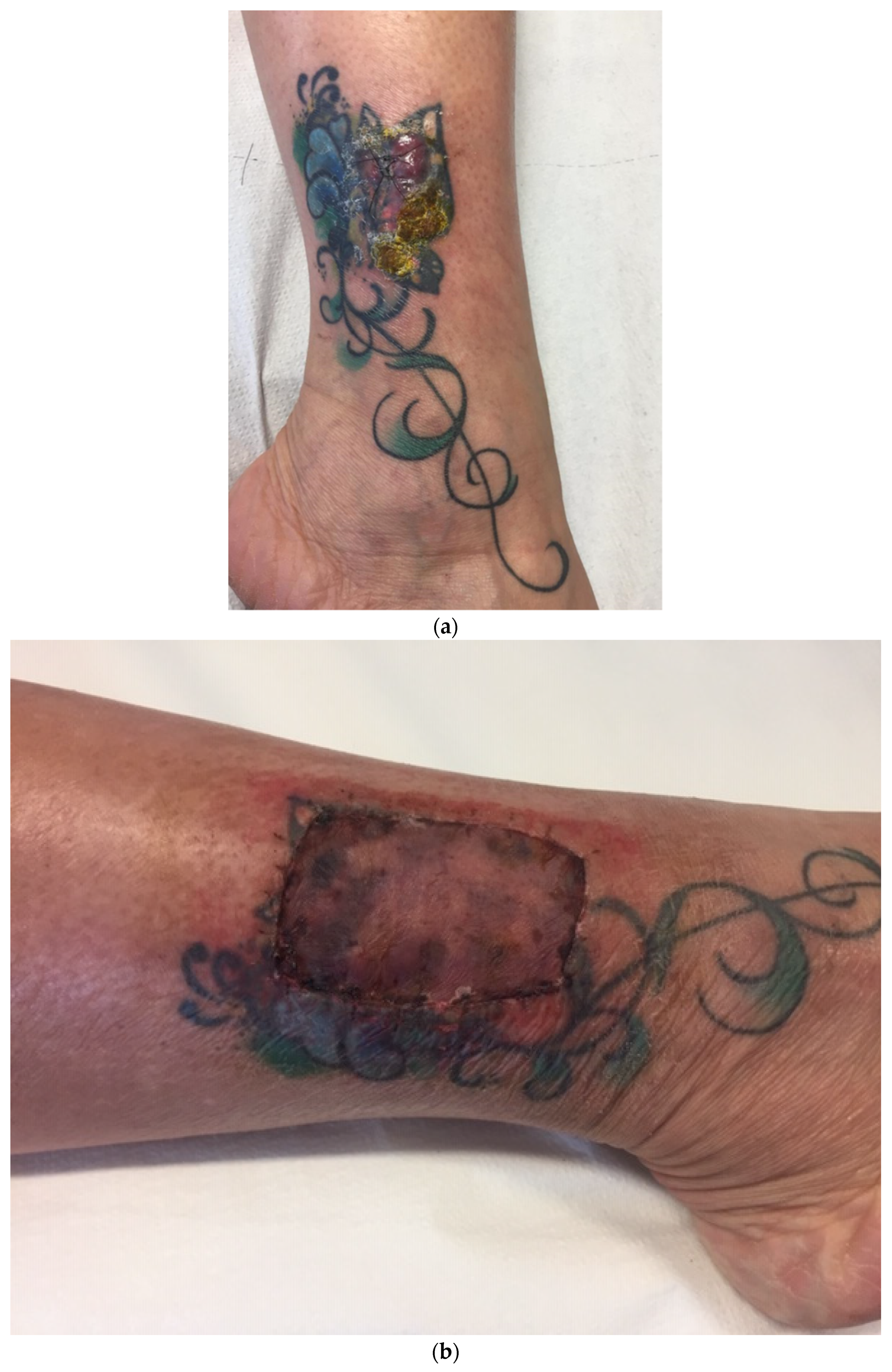A Peculiar Case of Allergic Granulomatous Reaction to Red Pigment: A Tattoo Touch-Up Treated Surgically
Abstract
:Author Contributions
Funding
Institutional Review Board Statement
Informed Consent Statement
Data Availability Statement
Conflicts of Interest
References
- Tammaro, A.; Raffa, S.; Petrigliano, N.; Zollo, V.; Gelormini, E.; Moliterni, E.; Magri, F.; Parisella, F.R.; Persechino, S. Marked pseudoepitheliomatous hyperplasia secondary to a red-pigmented tattoo: A case report. J. Eur. Acad. Dermatol. Venereol. 2018, 32, e272–e273. [Google Scholar] [CrossRef] [PubMed]
- Høgsberg, T.; Thomsen, B.M.; Serup, J. Histopathology and immune histochemistry of red tattoo reactions. Interface dermatitis is the lead pathology, with increase in T-lymphocytes and Langerhans cells suggesting an allergic pathomechanism. Skin Res. Technol. 2015, 21, 449–458. [Google Scholar] [CrossRef] [PubMed]
- Tammaro, A.; Toniolo, C.; Giulianelli, V.; Serafini, M.; Persechino, S. Chemical research on red pigments after adverse reactions to tattoo. Eur. Ann. Allergy Clin. Immunol. 2016, 48, 46–48. [Google Scholar] [PubMed]
- Serup, J.; Hutton Carlsen, K.; Dommershausen, N.; Sepehri, M.; Hesse, B.; Seim, C.; Luch, A.; Schreiver, I. Identification of pigments related to allergic tattoo reactions in 104 human skin biopsies. Contact Dermat. 2020, 82, 73–82. [Google Scholar] [CrossRef] [PubMed] [Green Version]
- Serup, J.; Sepehri, M.; Hutton Carlsen, K. Classification of Tattoo Complications in a Hospital Material of 493 Adverse Events. Dermatology 2016, 232, 668–678. [Google Scholar] [CrossRef] [PubMed]

Publisher’s Note: MDPI stays neutral with regard to jurisdictional claims in published maps and institutional affiliations. |
© 2021 by the authors. Licensee MDPI, Basel, Switzerland. This article is an open access article distributed under the terms and conditions of the Creative Commons Attribution (CC BY) license (https://creativecommons.org/licenses/by/4.0/).
Share and Cite
Tammaro, A.; Adebanjo, G.A.R.; Magri, F.; Chello, C.; Iacovino, C.; Parisella, F.R.; Capalbo, A.; Luzi, F.; De Marco, G. A Peculiar Case of Allergic Granulomatous Reaction to Red Pigment: A Tattoo Touch-Up Treated Surgically. Allergies 2021, 1, 137-139. https://doi.org/10.3390/allergies1030012
Tammaro A, Adebanjo GAR, Magri F, Chello C, Iacovino C, Parisella FR, Capalbo A, Luzi F, De Marco G. A Peculiar Case of Allergic Granulomatous Reaction to Red Pigment: A Tattoo Touch-Up Treated Surgically. Allergies. 2021; 1(3):137-139. https://doi.org/10.3390/allergies1030012
Chicago/Turabian StyleTammaro, Antonella, Ganiyat Adenike Ralitsa Adebanjo, Francesca Magri, Camilla Chello, Chiara Iacovino, Francesca Romana Parisella, Alessandro Capalbo, Fabiola Luzi, and Gabriella De Marco. 2021. "A Peculiar Case of Allergic Granulomatous Reaction to Red Pigment: A Tattoo Touch-Up Treated Surgically" Allergies 1, no. 3: 137-139. https://doi.org/10.3390/allergies1030012
APA StyleTammaro, A., Adebanjo, G. A. R., Magri, F., Chello, C., Iacovino, C., Parisella, F. R., Capalbo, A., Luzi, F., & De Marco, G. (2021). A Peculiar Case of Allergic Granulomatous Reaction to Red Pigment: A Tattoo Touch-Up Treated Surgically. Allergies, 1(3), 137-139. https://doi.org/10.3390/allergies1030012





